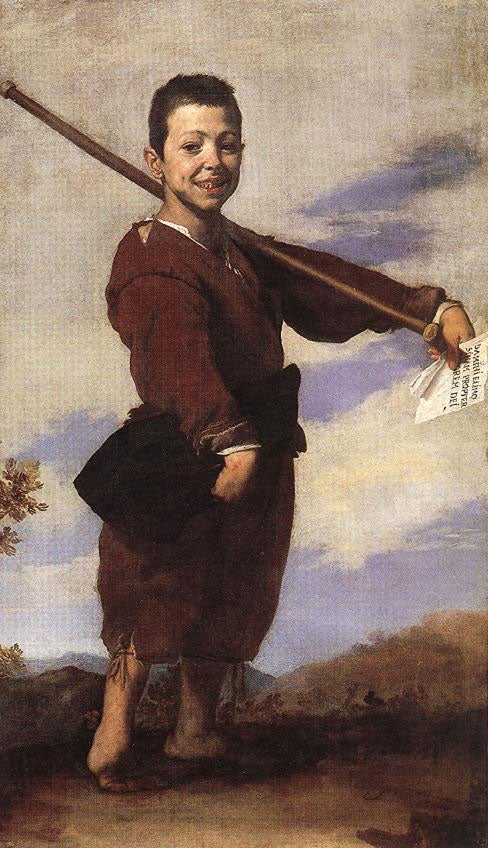de Ribera, Jusepe: The Boy with the Club Foot (1642)
The Independent's Great Art series

Also in this article:
About the artist
We have qualms about images of poverty. We have words – words such as picturesque, sentimental, romanticised, aestheticised, exploitative, voyeuristic, condescending, dehumanising – to express these qualms. But our qualms aren't new. In the middle of the 17th century, the Neapolitan artist Salvator Rosa wrote a satirical poem about painting. He aimed his scorn especially at those who painted pictures of beggars, and those who then bought them.
Such paintings demonstrated for Rosa the glaring gap between wealth and misery, and between taste and morality. "These pictures are so much appreciated/ That you see them in the homes of the powerful/ In superbly ornamented frames,/ While real life beggars, wretched and naked,/ Don't get a penny from the people/ Who will pay thousands for paintings of them..." He concluded, "Quel che aboriscon vivo, aman dipinto" ("What they abhor in life, they love to see in pictures").
Perhaps he had in mind a painting such as Jusepe de Ribera's The Boy with a Club Foot. It was painted in Naples a few years before the poem was written, and is explicitly a charity picture. The boy stands before us, holding a piece of paper on which is written: DA MIHI ELIMO SINAM PROPTER AMOREM DEI. Give me alms, for the love of God.
Whether this picture ever incited its first viewers to charitable action, or merely to charitable sentiments, we don't know. But you might think it was designed for neither purpose. Surely, what it tells us is that this boy can look after himself. The begging words of the caption seem at odds with the grandeur of the figure. It is an empowering image. It makes its stunted subject look like a giant. The boy stands full length, and fills the upright oblong of the canvas. The viewpoint is low, at ankle level. He towers above the narrow strip of earth, occupies the spreading sky. His dark clothes cut a bold silhouette against the light. The rising pockets of cloud and blue bear him upwards.
This limping beggar boy suggests to a modern viewer, not some abject figure from a "spastics" collection box, but a Soviet hero of labour. Well, that's not quite right, because the boy has something a hero of labour would never have: a conscious air of performance. The beggar's grandeur is bound up with his self-presentation. He stops, turns, gives us a look and a raw smile. He strikes a pose. He seems to know he's in a picture.
The crux is the crutch. He carries it sloped across his shoulder. He parades it, flourishes it, like a lance or standard. The boy's putting on a show for his audience, playing at soldiers. At the same time, the slanting crutch is a strong pictorial gesture. It extends exactly from one side of the frame to the other. It puts the figure in full command of the scene. He spans it, claims its whole breadth. It's as if he knew where the limits of his visibility lay.
He's putting himself on view, demanding attention. Ribera's painting glorifies this beggar (or mock-glorifies him) by its similarity to other kinds of attention-seeking image: full-length portraits of swaggering grandees; martyrs displaying their wounds and the instruments of their martyrdom; allegorical figures who address us, presenting their symbolic attributes.
But there's a more basic point: sheer, insistent visibility. A beggar must make himself conspicuous in order to live. His hearty performance is not play. He must attract attention. He must make an exhibition of himself. And in this picture, Ribera takes up the viewer's wish to look at picturesque beggars, and answers it with a real beggar's imperative need to be seen. Look at me. Notice me. Give me alms, for the love of God.
The artist
Jusepe de Ribera (1591-1652) is a master of rough glory, sombre vitality. Born in Spain, he spent his working life in Italy, in the Spanish colony of Naples. He picked up Caravaggio's high-contrast lighting and low-life milieu. He specialised in vigorous scenes of martyrdom and torture, with tormentors and victims looking equally energetic. He was interested in freaks and blindness, and introduced the subject of the beggar-philosopher later developed by his successor Velazquez.
Join our commenting forum
Join thought-provoking conversations, follow other Independent readers and see their replies
Comments
Bookmark popover
Removed from bookmarks